Abstract
TCDD and thyroxine have common molecular reactivity properties which enable them to present a planar face and lateral halogens in interactions with proteins. These molecular properties are consistent with the structure-toxicity relationship for TCDD and related compounds. Biological evidence is discussed including preliminary studies on the effects of TCDD exposure on tadpole growth and development which is consistent with the possible thyroxine-like activity of TCDD. The work suggests the possibility that toxicity is at least in part the expression of potent and persistent thyroid hormone activity (responses induced by TCDD which qualitatively correspond to those mediated by thyroid hormones). A mechanism for toxicity is proposed which involves receptor proteins; the planar aromatic system controls binding to cytosolic proteins and halogen substituents regulate binding to nuclear proteins. This simple model based on molecular reactivity sheds light on the diversified effects of TCDD and related compound toxicity and on certain thyroid hormone action. The model also permits predictions to be made with regard to the toxicity and thyroid hormone activity of untested compounds. In addition, the model suggests a general mechanism for hormone action based on metabolically regulated differential and cooperative protein receptor binding events in cellular compartments which can explain agonism, antagonism and potentiation within the framework of receptor occupancy theory.
Full text
PDF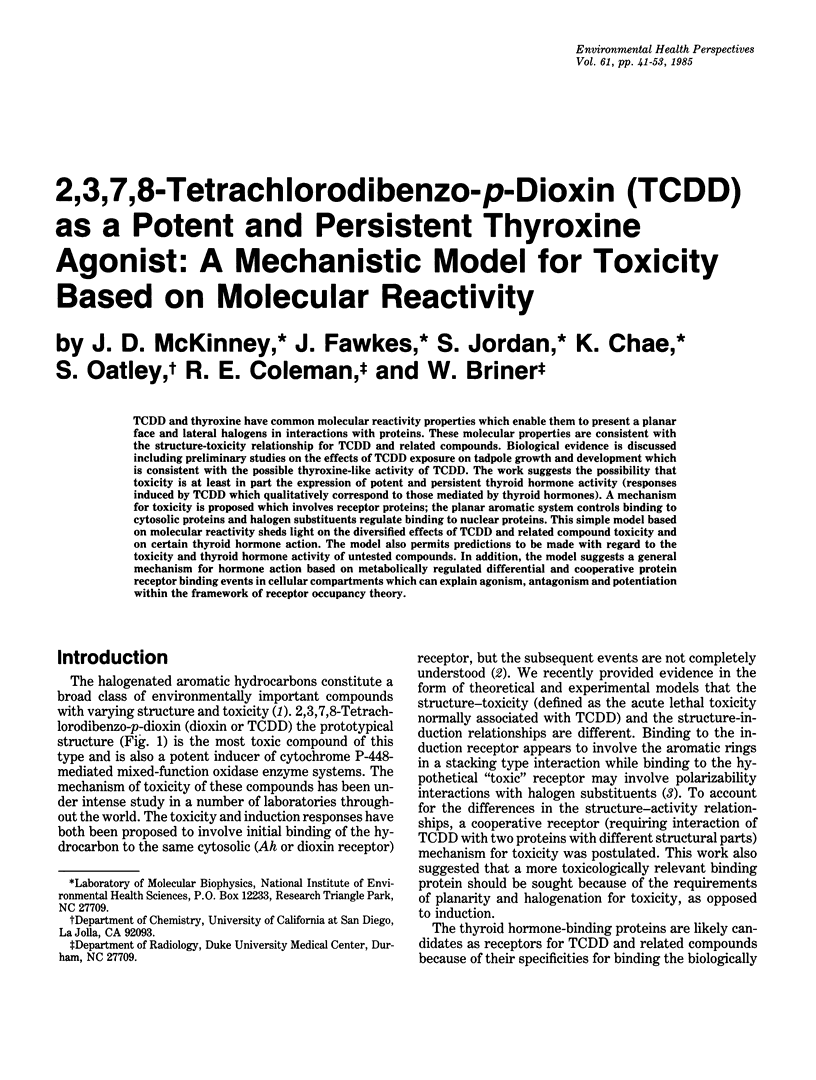

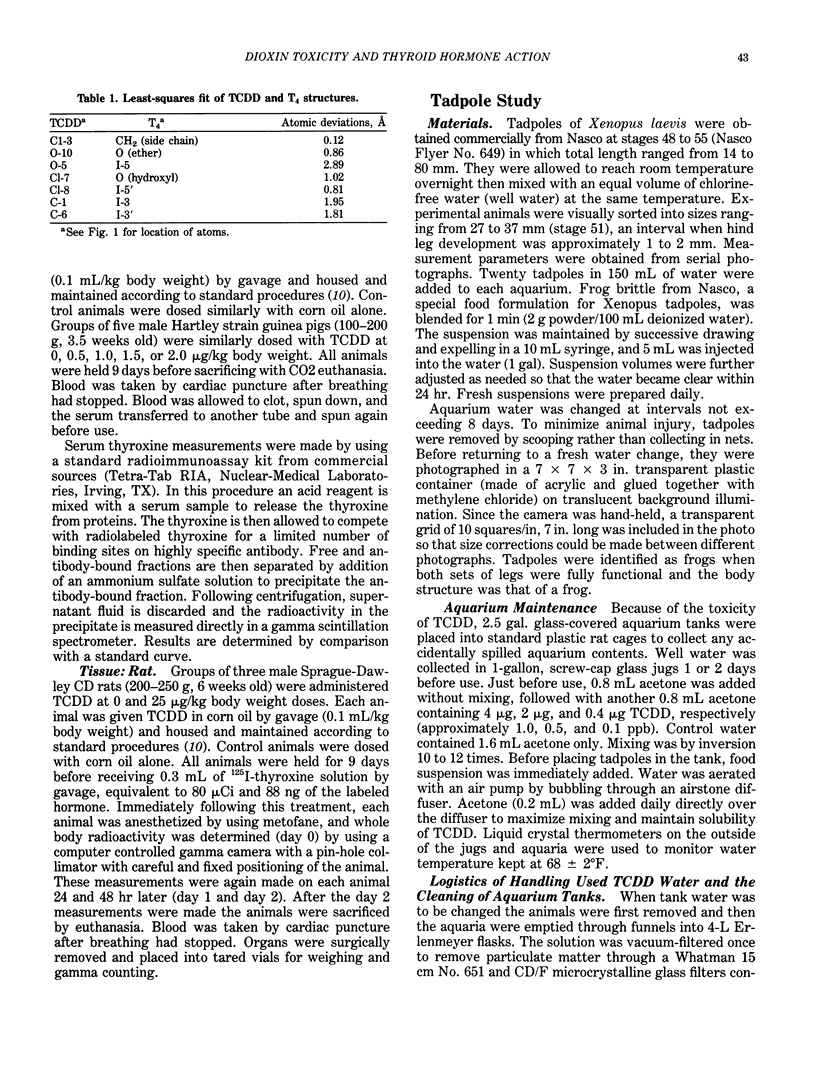
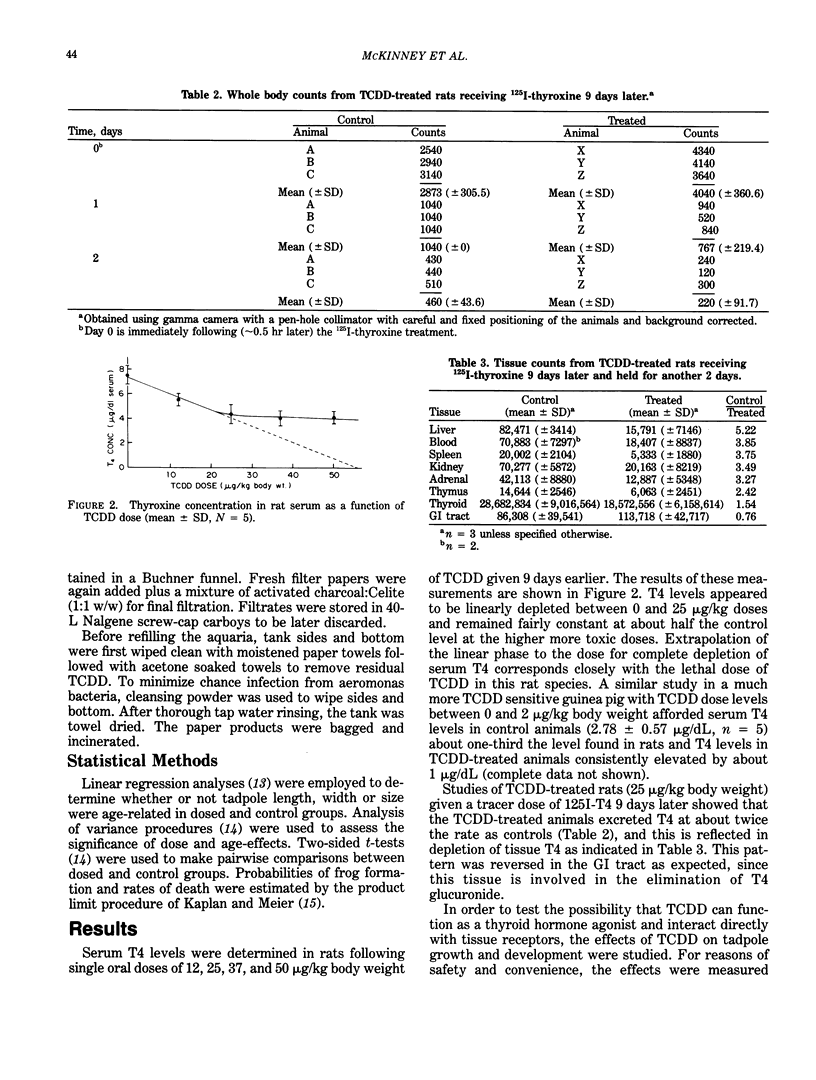
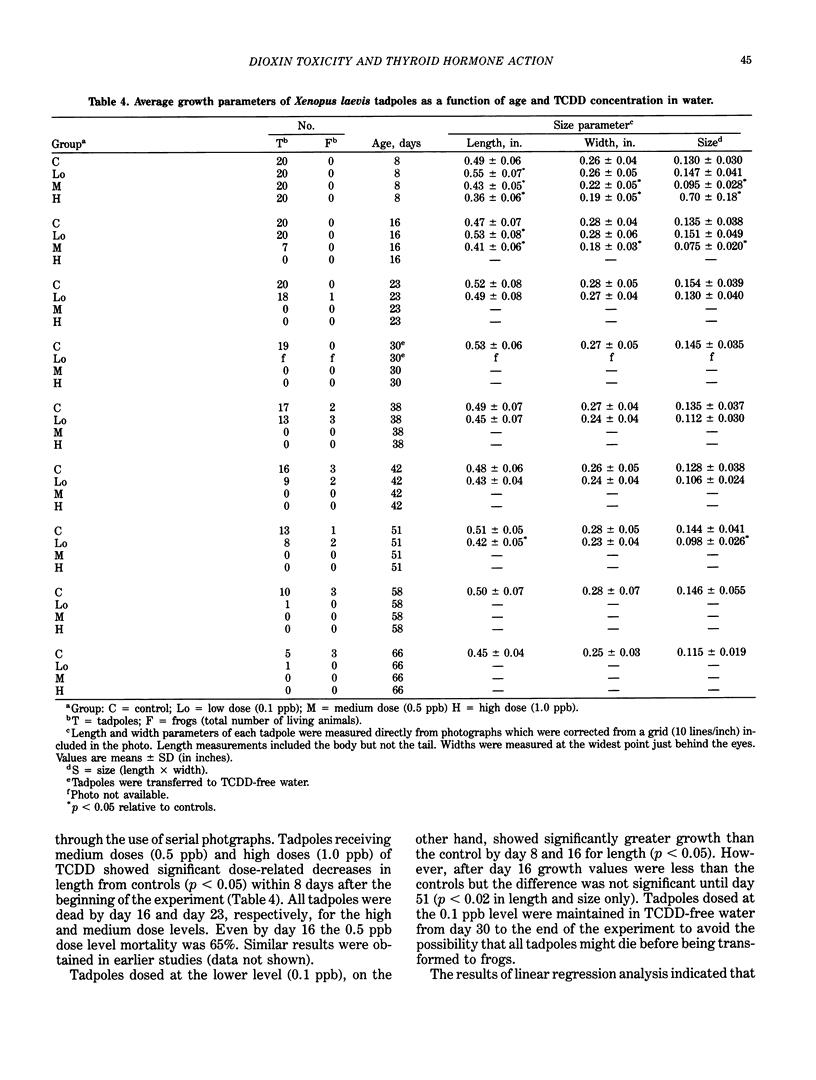
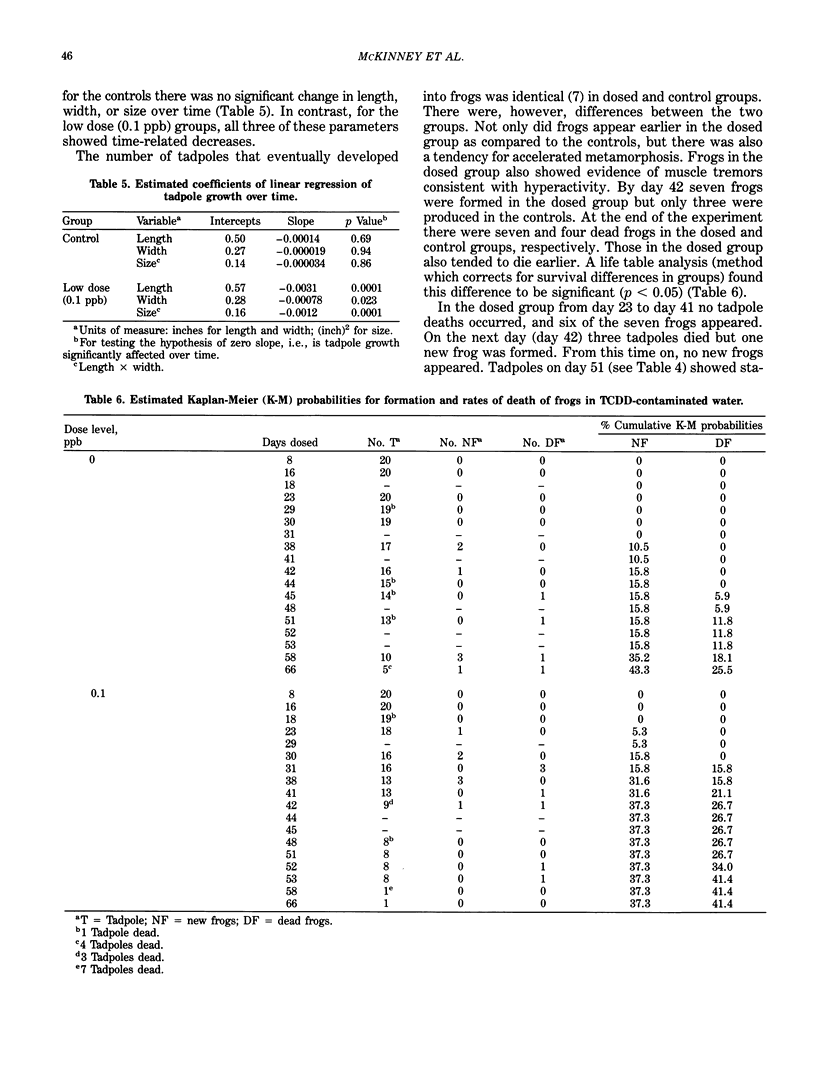
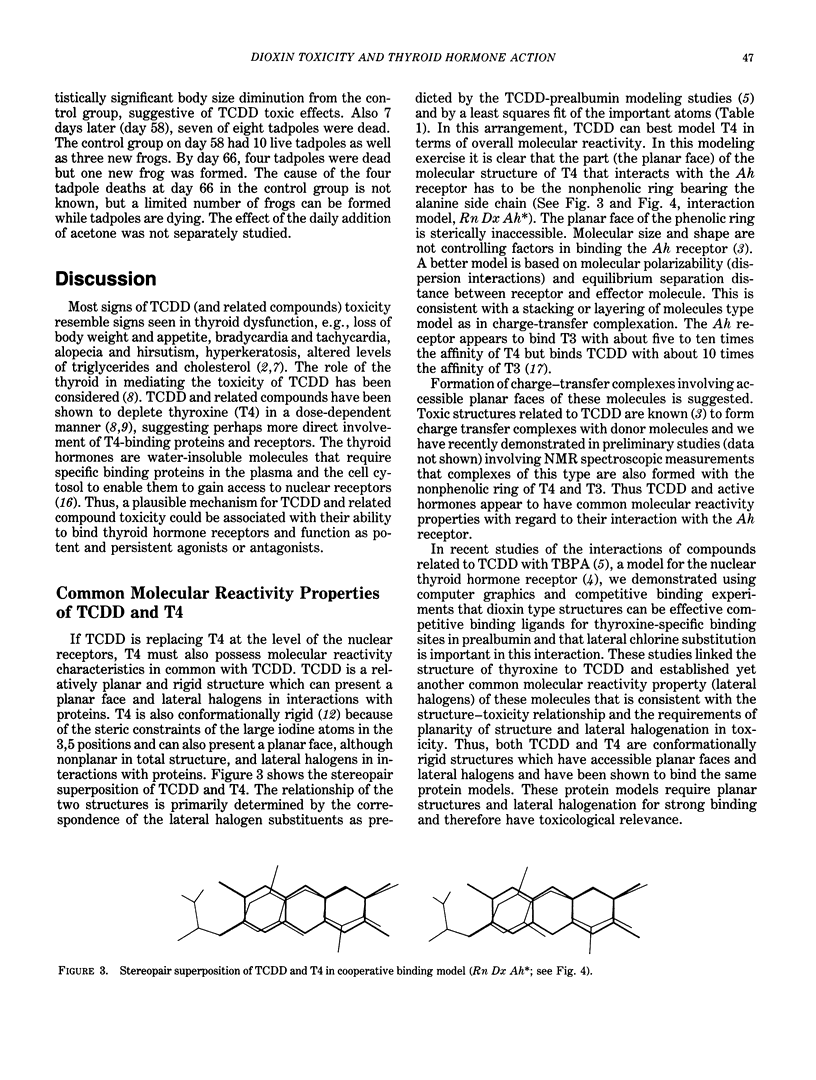
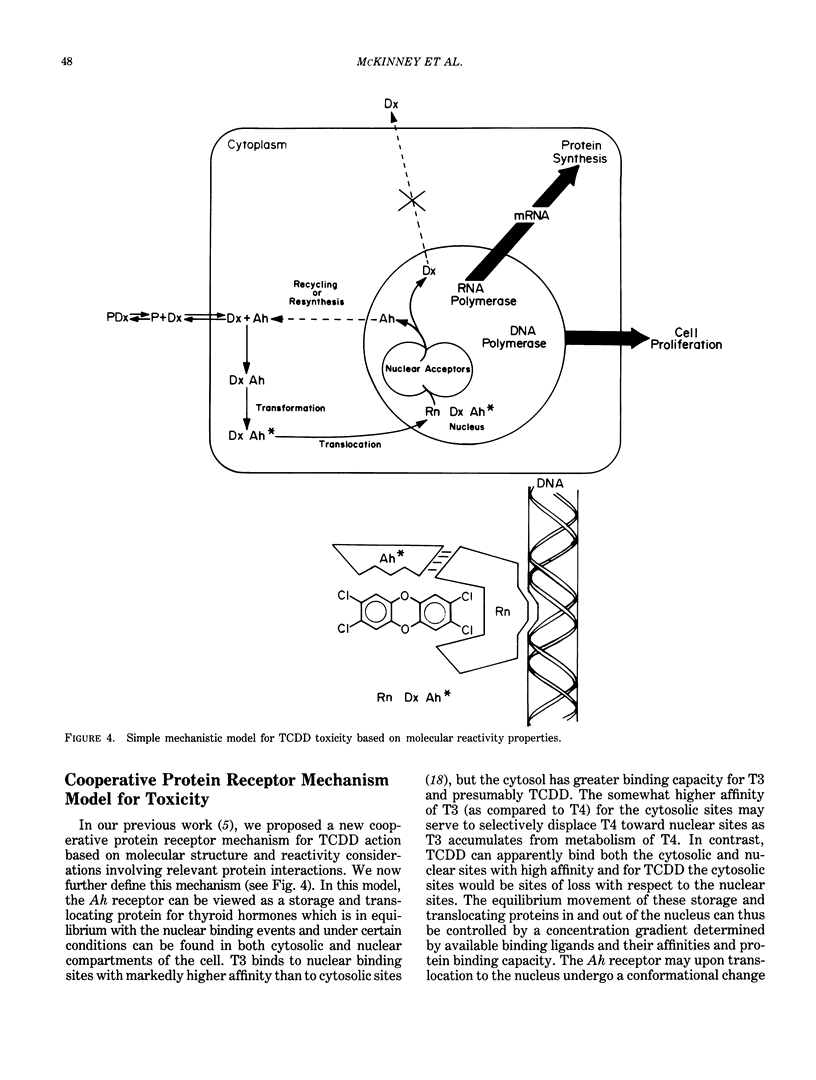
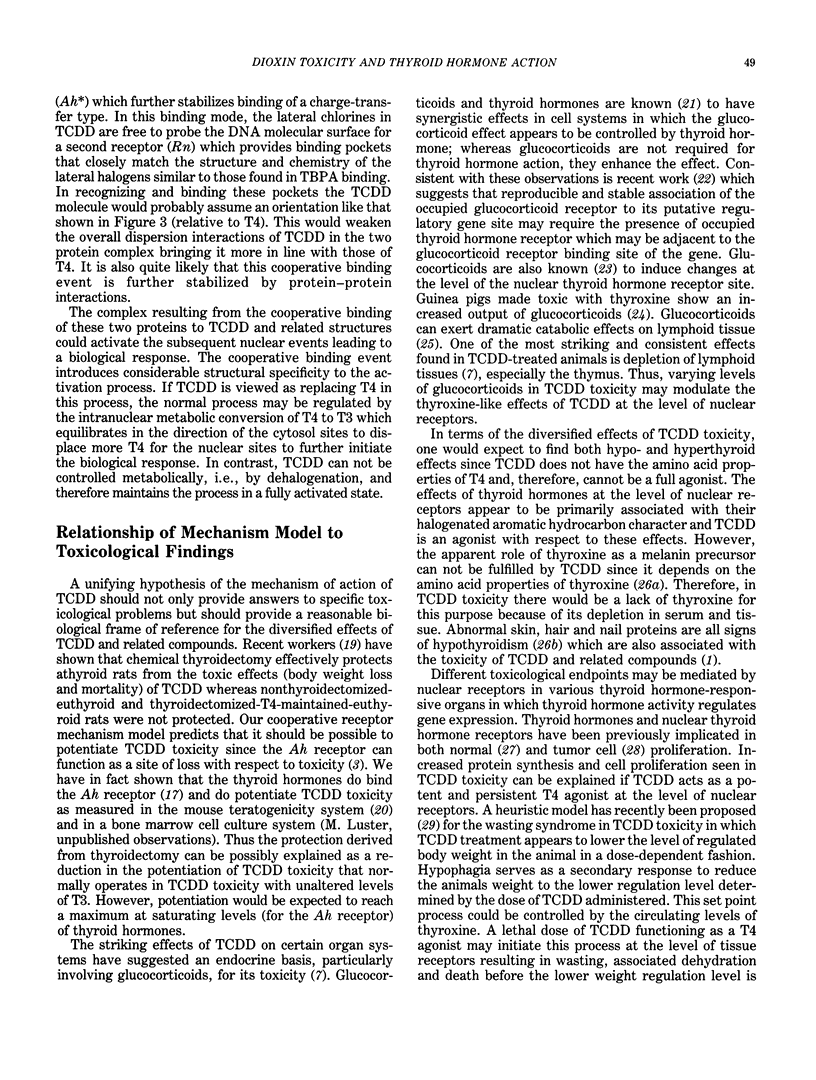
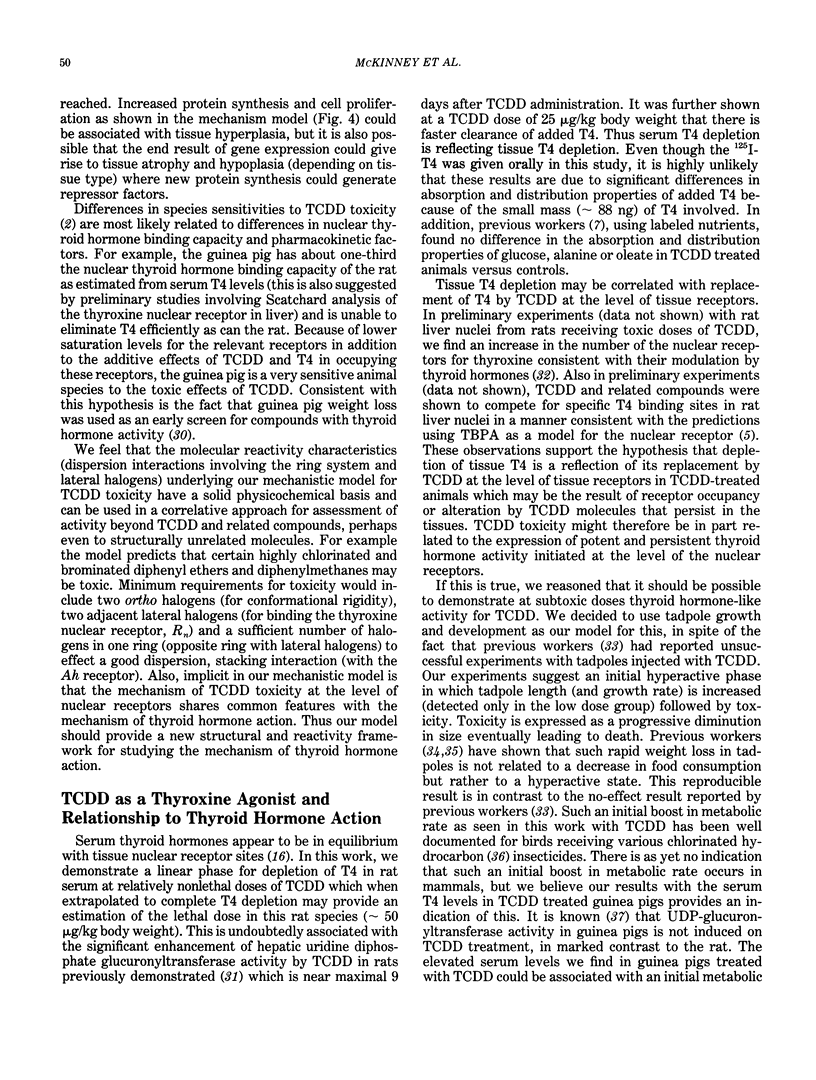
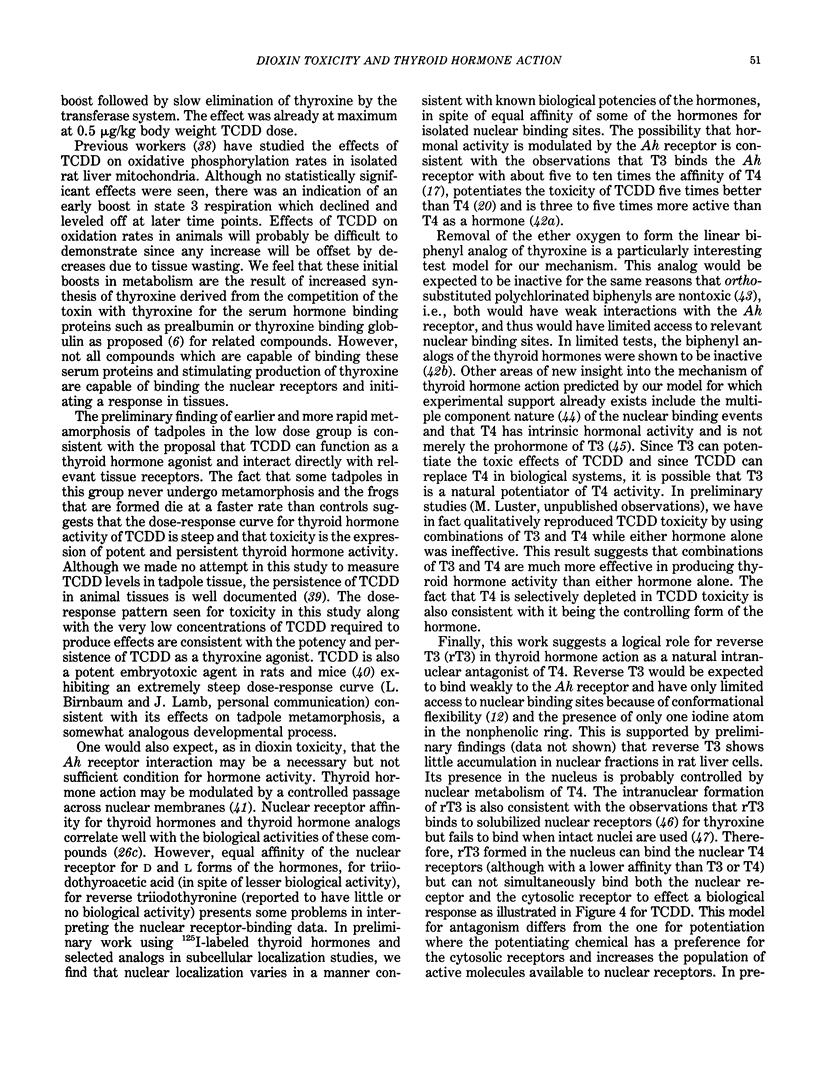
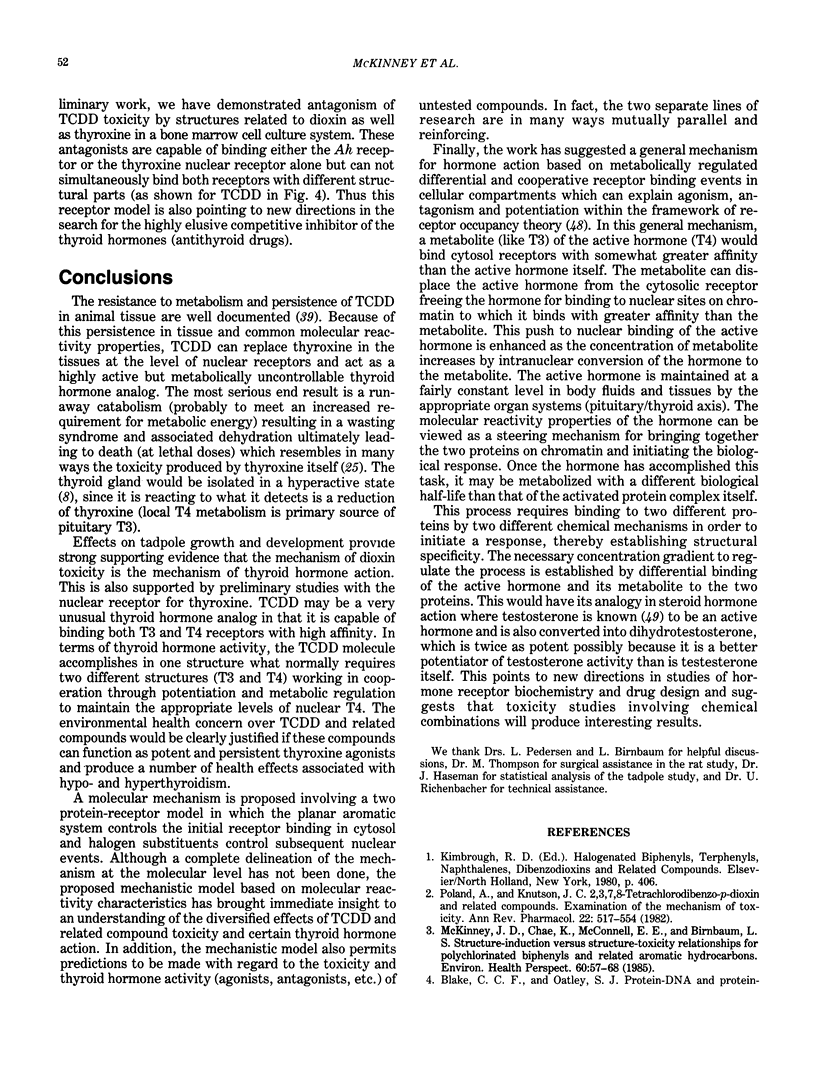
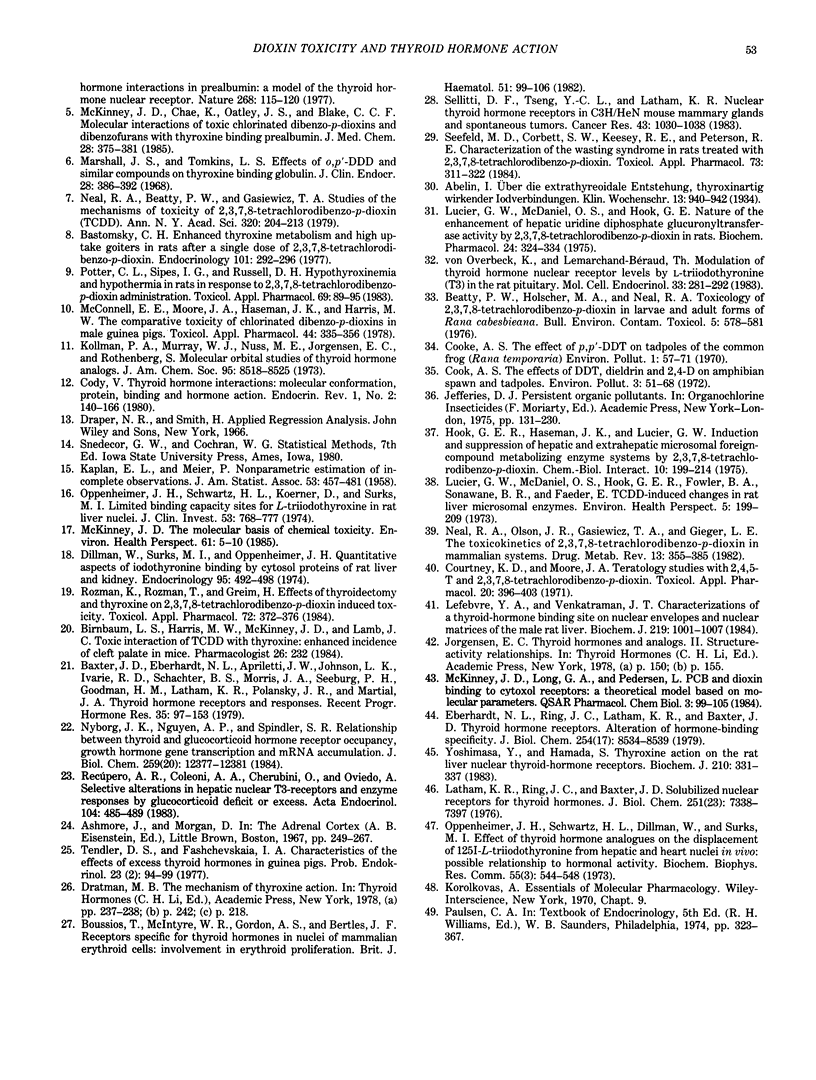
Selected References
These references are in PubMed. This may not be the complete list of references from this article.
- Bastomsky C. H. Enhanced thyroxine metabolism and high uptake goiters in rats after a single dose of 2,3,7,8-tetrachlorodibenzo-p-dioxin. Endocrinology. 1977 Jul;101(1):292–296. doi: 10.1210/endo-101-1-292. [DOI] [PubMed] [Google Scholar]
- Baxter J. D., Eberhardt N. L., Apriletti J. W., Johnson L. K., Ivarie R. D., Schachter B. S., Morris J. A., Seeburg P. H., Goodman H. M., Latham K. R. Thyroid hormone receptors and responses. Recent Prog Horm Res. 1979;35:97–153. [PubMed] [Google Scholar]
- Beatty P. W., Holscher M. A., Neal R. A. Toxicity of 2, 3, 7, 8-tetrachlorodibenzo-p-dioxin in larval and adult forms of Rana catesbeiana. Bull Environ Contam Toxicol. 1976 Nov;16(5):578–581. doi: 10.1007/BF01685367. [DOI] [PubMed] [Google Scholar]
- Blake C. C., Oatley S. J. Protein-DNA and protein-hormone interactions in prealbumin: a model of the thyroid hormone nuclear receptor? Nature. 1977 Jul 14;268(5616):115–120. doi: 10.1038/268115a0. [DOI] [PubMed] [Google Scholar]
- Boussios T., McIntyre W. R., Gordon A. S., Bertles J. F. Receptors specific for thyroid hormones in nuclei of mammalian erythroid cells: involvement in erythroid cell proliferation. Br J Haematol. 1982 May;51(1):99–106. doi: 10.1111/j.1365-2141.1982.tb07294.x. [DOI] [PubMed] [Google Scholar]
- Cody V. Thyroid hormone interactions: molecular conformation, protein binding, and hormone action. Endocr Rev. 1980 Spring;1(2):140–166. doi: 10.1210/edrv-1-2-140. [DOI] [PubMed] [Google Scholar]
- Courtney K. D., Moore J. A. Teratology studies with 2,4,5-trichlorophenoxyacetic acid and 2,3,7,8-tetrachlorodibenzo-p-dioxin. Toxicol Appl Pharmacol. 1971 Nov;20(3):396–403. doi: 10.1016/0041-008x(71)90282-1. [DOI] [PubMed] [Google Scholar]
- Dillman W., Surks M. I., Oppenheimer J. H. Quantitative aspects of iodothyronine binding by cytosol proteins of rat liver and kidney. Endocrinology. 1974 Aug;95(2):492–498. doi: 10.1210/endo-95-2-492. [DOI] [PubMed] [Google Scholar]
- Eberhardt N. L., Ring J. C., Latham K. R., Baxter J. D. Thyroid hormone receptors. Alteration of hormone-binding specificity. J Biol Chem. 1979 Sep 10;254(17):8534–8539. [PubMed] [Google Scholar]
- FOLDI M., KOVACH A. G., SOLTI F., REV J., REFI Z., HERMANN R., KOLTEY E. Uber Crataeguswirkungen auf die Nierenfunktion beim Menschen. Dtsch Med J. 1959 Apr 1;10(6):164–166. [PubMed] [Google Scholar]
- Hook G. E., Haseman J. K., Lucier G. W. Induction and suppression of hepatic and extrahepatic microsomal foreign-compound-metabolizing enzyme systems by 2,3,7,8-tetrachlorodibenzo-p-dioxin. Chem Biol Interact. 1975 Mar;10(3):199–214. doi: 10.1016/0009-2797(75)90113-1. [DOI] [PubMed] [Google Scholar]
- Kollman P. A., Murray W. J., Nuss M. E., Jorgensen E. C., Rothenberg S. Molecular orbital studies of thyroid hormone analogs. J Am Chem Soc. 1973 Dec 26;95(26):8518–8525. doi: 10.1021/ja00807a004. [DOI] [PubMed] [Google Scholar]
- Latham K. R., Ring J. C., Baxter J. D. Solubilized nuclear "receptors" for thyroid hormones. Physical characteristics and binding properties, evidence for multiple forms. J Biol Chem. 1976 Dec 10;251(23):7388–7397. [PubMed] [Google Scholar]
- Lefebvre Y. A., Venkatraman J. T. Characterization of a thyroid-hormone-binding site on nuclear envelopes and nuclear matrices of the male-rat liver. Biochem J. 1984 May 1;219(3):1001–1007. doi: 10.1042/bj2191001. [DOI] [PMC free article] [PubMed] [Google Scholar]
- Lucier G. W., McDaniel O. S., Hook G. E., Fowler B. A., Sonawane B. R., Faeder E. TCDD-induced changes in rat liver microsomal enzymes. Environ Health Perspect. 1973 Sep;5:199–209. doi: 10.1289/ehp.7305199. [DOI] [PMC free article] [PubMed] [Google Scholar]
- Lucier G. W., McDaniel O. S., Hook G. E. Nature of the enhancement of hepatic uridine diphosphate glucuronyltransferase activity by 2,3,7,8-tetrachlorodibenzo-p-dioxin in rats. Biochem Pharmacol. 1975 Feb 1;24(3):325–334. doi: 10.1016/0006-2952(75)90213-0. [DOI] [PubMed] [Google Scholar]
- Marshall J. S., Tompkins L. S. Effect of o,p'-DDD and similar compounds on thyroxine binding globulin. J Clin Endocrinol Metab. 1968 Mar;28(3):386–392. doi: 10.1210/jcem-28-3-386. [DOI] [PubMed] [Google Scholar]
- McConnell E. E., Moore J. A., Haseman J. K., Harris M. W. The comparative toxicity of chlorinated dibenzo-p-dioxins in mice and guinea pigs. Toxicol Appl Pharmacol. 1978 May;44(2):335–356. doi: 10.1016/0041-008x(78)90195-3. [DOI] [PubMed] [Google Scholar]
- McKinney J. D., Chae K., McConnell E. E., Birnbaum L. S. Structure-induction versus structure-toxicity relationships for polychlorinated biphenyls and related aromatic hydrocarbons. Environ Health Perspect. 1985 May;60:57–68. doi: 10.1289/ehp.856057. [DOI] [PMC free article] [PubMed] [Google Scholar]
- McKinney J. D., Chae K., Oatley S. J., Blake C. C. Molecular interactions of toxic chlorinated dibenzo-p-dioxins and dibenzofurans with thyroxine binding prealbumin. J Med Chem. 1985 Mar;28(3):375–381. doi: 10.1021/jm00381a018. [DOI] [PubMed] [Google Scholar]
- McKinney J. D. The molecular basis of chemical toxicity. Environ Health Perspect. 1985 Sep;61:5–10. doi: 10.1289/ehp.85615. [DOI] [PMC free article] [PubMed] [Google Scholar]
- Neal R. A., Beatty P. W., Gasiewicz T. A. Studies of the mechanisms of toxicity of 2,3,7,8-tetrachlorodibenzo-p-dioxin (TCDD). Ann N Y Acad Sci. 1979 May 31;320:204–213. doi: 10.1111/j.1749-6632.1979.tb56602.x. [DOI] [PubMed] [Google Scholar]
- Neal R. A., Olson J. R., Gasiewicz T. A., Geiger L. E. The toxicokinetics of 2, 3, 7, 8-tetrachlorodibenzo-p-dioxin in mammalian systems. Drug Metab Rev. 1982;13(3):355–385. doi: 10.3109/03602538209029985. [DOI] [PubMed] [Google Scholar]
- Nyborg J. K., Nguyen A. P., Spindler S. R. Relationship between thyroid and glucocorticoid hormone receptor occupancy, growth hormone gene transcription, and mRNA accumulation. J Biol Chem. 1984 Oct 25;259(20):12377–12381. [PubMed] [Google Scholar]
- Oppenheimer J. H., Schwartz H. L., Dillman W., Surks M. I. Effect of thyroid hormone analogues on the displacement of 125I-L-triiodothyronine from hepatic and heart nuclei in vivo: possible relationship to hormonal activity. Biochem Biophys Res Commun. 1973 Dec 10;55(3):544–550. doi: 10.1016/0006-291x(73)91177-7. [DOI] [PubMed] [Google Scholar]
- Oppenheimer J. H., Schwartz H. L., Koerner D., Surks M. I. Limited binding capacity sites for L-triiodothyronine in rat liver nuclei. Nuclear-cytoplasmic interrelation, binding constants, and cross-reactivity with L-thyroxine. J Clin Invest. 1974 Mar;53(3):768–777. doi: 10.1172/JCI107615. [DOI] [PMC free article] [PubMed] [Google Scholar]
- Poland A., Knutson J. C. 2,3,7,8-tetrachlorodibenzo-p-dioxin and related halogenated aromatic hydrocarbons: examination of the mechanism of toxicity. Annu Rev Pharmacol Toxicol. 1982;22:517–554. doi: 10.1146/annurev.pa.22.040182.002505. [DOI] [PubMed] [Google Scholar]
- Potter C. L., Sipes I. G., Russell D. H. Hypothyroxinemia and hypothermia in rats in response to 2,3,7,8-tetrachlorodibenzo-p-dioxin administration. Toxicol Appl Pharmacol. 1983 Jun 15;69(1):89–95. doi: 10.1016/0041-008x(83)90123-0. [DOI] [PubMed] [Google Scholar]
- Recúpero A. R., Coleoni A. H., Cherubini O., Oviedo A. Selective alterations in hepatic nuclear T3-receptors and enzyme responses by glucocorticoid deficit or excess. Acta Endocrinol (Copenh) 1983 Dec;104(4):485–489. doi: 10.1530/acta.0.1040485. [DOI] [PubMed] [Google Scholar]
- Rozman K., Rozman T., Greim H. Effect of thyroidectomy and thyroxine on 2,3,7,8-tetrachlorodibenzo-p-dioxin (TCDD) induced toxicity. Toxicol Appl Pharmacol. 1984 Feb;72(2):372–376. doi: 10.1016/0041-008x(84)90322-3. [DOI] [PubMed] [Google Scholar]
- Seefeld M. D., Corbett S. W., Keesey R. E., Peterson R. E. Characterization of the wasting syndrome in rats treated with 2,3,7,8-tetrachlorodibenzo-p-dioxin. Toxicol Appl Pharmacol. 1984 Apr;73(2):311–322. doi: 10.1016/0041-008x(84)90337-5. [DOI] [PubMed] [Google Scholar]
- Sellitti D. F., Tseng Y. C., Latham K. R. Nuclear thyroid hormone receptors in C3H/HeN mouse mammary glands and spontaneous tumors. Cancer Res. 1983 Mar;43(3):1030–1038. [PubMed] [Google Scholar]
- Yoshimasa Y., Hamada S. Thyroxine action on the rat liver nuclear thyroid-hormone receptors. Binding of thyroxine to the nuclear non-histone protein and induction of mitochondrial alpha-glycerophosphate dehydrogenase activity. Biochem J. 1983 Feb 15;210(2):331–337. doi: 10.1042/bj2100331. [DOI] [PMC free article] [PubMed] [Google Scholar]
- von Overbeck K., Lemarchand-Béraud T. Modulation of thyroid hormone nuclear receptor levels by L-triiodothyronine (T3) in the rat pituitary. Mol Cell Endocrinol. 1983 Dec;33(2-3):281–292. doi: 10.1016/0303-7207(83)90173-9. [DOI] [PubMed] [Google Scholar]


